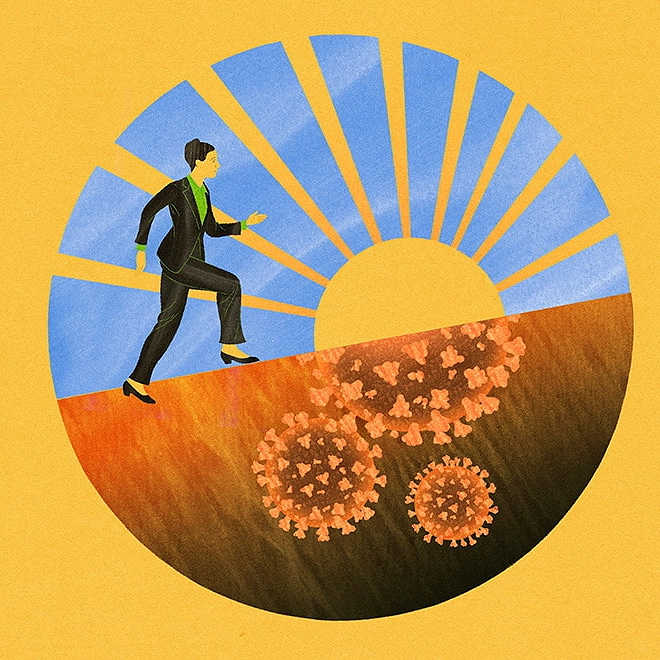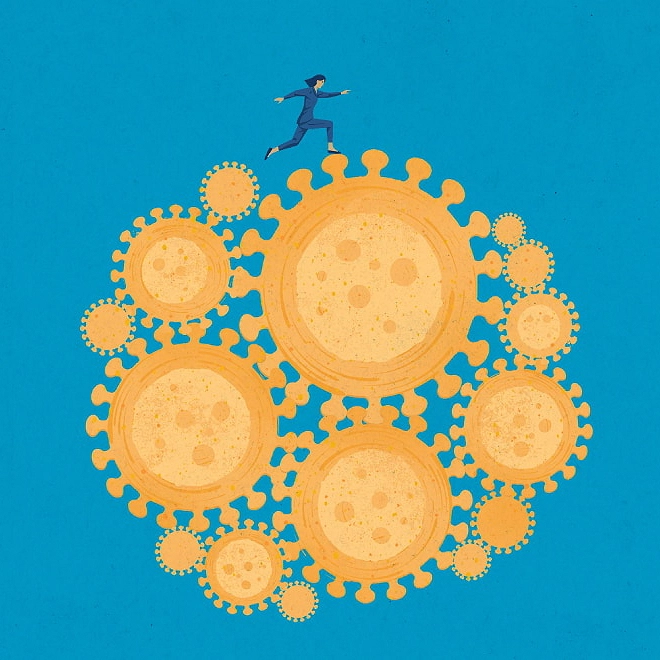The journey of resilient leadership
Building organizational resilience
Resilient organizations rapidly and successfully cycle through three phases—Respond, Recover, Thrive—not just for COVID-19 but for every crisis. Here are four actions to improve organizational resilience.
“Travelers, there is no road; you make your own path as you walk.”
—Spanish poet Antonio Machado1
IN 2020, resilient leadership has been tested in the extreme, and the challenges continue. As I write this, many countries around the globe are contending with the resurgence of COVID-19 and the prospect of continued, new, and extended lockdowns—against a backdrop of social, political, and economic upheaval that makes the terrain even harder to navigate.
This crisis is taking its toll on organizations and individuals. In October, Deloitte and Fortune surveyed more than 125 CEOs in the global Fortune CEO community who revealed that their four greatest challenges during this difficult year have been maintaining employee well-being, sustaining innovation, addressing declining revenues, and engaging customers (see figure 1, from the Fortune/Deloitte CEO Survey2). Ninety percent of these CEOs have taken action to support their employees’ mental health over the past six months.3 Meanwhile, many organizations’ customers are in a similar frame of mind. In the most recent biweekly Deloitte State of the Consumer Tracker, consumers in 15 of the 18 countries surveyed globally identify as health-anxious rather than health-hopeful.4
Learn more
Learn more about connecting for a resilient world
Connect with our COVID-19 client PMO for help at covidclientpmo@deloitte.com

While promising results from vaccine trials—perceived by global CEOs as the highest priority on the path to recovery5—encourage us to set our sights on a “better normal,” progress has been more looping than linear. Regardless of where each of our organizations is on the journey from Respond to Recover to Thrive, virtually every CEO I interact with agrees on one thing: The journey involves an ever-accelerating pace of change.
Achieving a better normal is not just about having a better map; it’s about having the nimble team, resources, and systems that enable us to thrive before, during, and after change (especially adversity). It’s about having a resilient organization.
In our article on the Recover phase, we said:
Resilience is not a destination; it is a way of being. A “resilient organization” is not one that is simply able to return to where it left off before the crisis. Rather, the truly resilient organization is one that has transformed, having built the attitudes, beliefs, agility, and structures into its DNA that enable it to not just recover to where it was, but vault forward—quickly.
What are the key executive actions on this transformation to resilience?
- Beliefs: Explore and leverage value-creating opportunities on the trail of the pandemic’s disruption.
- Attitudes: Model and lead your executive team and organization through the essential mindset shifts to navigate the path to resiliency.
- Agility: Embrace collective agility by convening a cross section of stakeholders to codesign the answers to company-critical challenges.
- Structures: Ensure that specific C-suite members are accountable for the seven key elements of a resilient organization.
When organizations, people, institutions, and society collectively thrive, the outcome is a resilient world. It is intentional—not accidental—and we can shape the future by building resilient organizations.
“Resilience … is about how we acknowledge, respond to, and rise above chaos, and how we act on the other side of that disruption.”6
—Kevin Sowers, president of Johns Hopkins Health System and executive vice president of Johns Hopkins Medicine
Value-creating discoveries on the trail of market disruptions
COVID-19 has demonstrated how history moves in fits and starts of great, eruptive change.7 Today, concurrent epidemiological, economic, social, and environmental discontinuities are individually disruptive and collectively amplified as seismic shifts in business and society.
Resilient leaders know that responding to disruption with agility is about more than survival. It’s about uncovering value. Discontinuities create obstacles, but also open new paths for discoveries and value creation. Market structures, business models, ecosystem relationships, and customer needs are dramatically reshaped, and the winners script the future. The same has been true during the COVID-19 market disruption (see figure 2).

Mindset shifts to navigate the path to resiliency
In our previous article on the Recover phase, we described the important mindset shifts that resilient leaders and their organizations must embrace in the journey from Respond to Recover. Turning your organization’s focus to Thrive requires another set of such shifts with a further focus on the future (see figure 3).

The situation pivots from a tenuous interim normal to actively pursuing a better normal. Leaders must therefore chart their organization’s strategic destination as it emerges into Thrive. Our Fortune/Deloitte CEO survey signaled key elements of that better normal: 96% of CEOs said that diversity, equity, and inclusion are strategic priorities, and 78% expect a consistent focus on sustainability and carbon reduction.16
The leadership attitude shifts from reinventing ways of doing business in the interim to a pioneering ethos, one in which you focus on inspiring and empowering the team to follow you.
During the Recover phase, the focus shifted from internal to market-facing. Now, however, we shift to market-making: How might we better contribute to the evolution in our existing markets? What new markets are emerging for us to own? Seventy-four percent of the CEOs in the Fortune/Deloitte CEO survey expect the crisis to create significant new market-making opportunities.17
Planning shifts from medium-term scenarios that ensure financial and operational viability to true, longer-term strategic visioning—methodically designing and embarking on the journey to the Thrive destination.
Management shifts from sustaining or surviving during Recover to building the resiliency and agility to return to business as unusual. The case for agile management is made by the 85% of global CEOs who said the crisis has significantly accelerated digital transformation and the 40% who are redesigning their supply chains.18
Collective agility: Codesigning the journey with the whole system
We often consider agility as describing a single unit—whether an individual or an organization—moving quickly and nimbly to adapt to change. Yet today’s major issues require entire systems to be agile and adaptable. For example, systems of attitudes, institutions, and behaviors have allowed and exacerbated racial inequity. Climate change has accelerated due in part to actions and reactions across a vast network of natural and manmade systems.
These are whole-system challenges that cannot be solved piecemeal; they require whole-system answers. Today’s resilient leaders build resiliency by convening the full ecosystem to collaborate and define the journey together. In other words, it’s about collective agility.
As my colleagues have seen in their work with various client organizations, the accelerated delivery of viable vaccines demonstrates this type of collective agility across a whole system of stakeholders. These might include: pharmaceutical companies; government organizations such as the European Medicines Agency (approvals), the Centers for Disease Control and Prevention (vaccine handling, distribution, and tracking), and supply chain coordination (US distribution through “Operation Warp Speed”); pharmaceutical distributors; multiple for-profit and not-for-profit health care systems; and multiple retailers with pharmacy services.
Such collective agility invites a vertical and horizontal cross section of the system to codesign the strategic destination, new business models, and the route. The advantages of such collaborative codesign include:
- Requires less buy-in: Rather than an isolated group of executives developing a strategy they must sell to stakeholders, the participants who are engaged in codesign have their fingerprints on the solution. They have a vested interest in its success, becoming cascading sponsors for the strategic decisions and their successful implementation.
- Ensures an outside-in perspective: Intentionally engaging stakeholders outside the organization reduces the likelihood of narrow answers to challenges requiring a broader perspective. Leaders who can leverage the innovative thinking and resourcefulness of their stakeholders will be better positioned to recover, and ultimately to thrive.
- Accelerates decision-making: Many strategic development processes take place serially, requiring more time to make decisions and shuttle diplomacy to reconcile differing views. Assembling representatives of the whole system to codesign together enables the strategic work to be done in parallel, thereby reducing elapsed time and improving the organization’s ability to respond to rapidly emerging market conditions.
To achieve these benefits, we engage a cross section of an organization’s whole system in executive accelerators such as collaboration labs in which the participants codesign the answers to some of the most perplexing, company-critical issues.
Collaborative codesign is especially important amidst the COVID-19 crisis: It can be both cathartic and energizing for people. Teams have been worn down by the seemingly endless uncertainty, familial strain, health threats, and ambiguous loss19 that has characterized this extended period of the virus.20 The very act of inviting them to imagine a successful, thriving future state and the path to get there can be a source of hope and encouragement, restore a feeling of control in the present, reduce stress, and sustain them.
Embracing seven elements of a resilient organization
Based on our conversations with Deloitte’s clients and client-serving executives around the globe, we’ve found that the vast majority of organizational needs cluster into one of seven categories: strategy, growth, operations, technology, work, capital, and society. We’ve interpreted these needs as seven elements of a resilient organization, and defined an outcome-based aspiration and focus for each (see figure 4).

Each of these elements needs to be strong independently. Taken together, the seven elements operate within a cohesive, interdependent web that reinforces each of the parts and enhances the adaptability of the organization.
We engaged with over 1,000 C-suite executives; analyzed their insights, questions, concerns, and initiatives around the journey to resiliency; and evaluated the highest-priority actions that leaders were taking in each of the key elements. We mapped these actions to their typical C-suite owners—those roles that had primary or secondary responsibility for the actions—to create a high-level playbook for the resilient organization (see figure 5).

Connecting for a resilient world
At an institutional level, value-creation discoveries, mindset shifts, collective agility, and the seven elements bring together resilient organizations and their ecosystems into an interconnected web of resiliency and strength.
At an individual level, five of the most common traits in resilient leaders are adaptability, preparedness, collaboration, responsibility, and ethics (see Deloitte’s forthcoming annual Resiliency Report, a survey of more than 2,200 C-suite executives in 21 countries to be released in January 2021). All five involve connecting: Adaptability quickly connects resources to meet today’s challenges; preparedness connects tomorrow’s resources to potential future scenarios; collaboration connects the whole system; and both responsibility and ethics connect individuals, organizations, institutions, and society.
Our mandate as resilient leaders is connecting for a resilient world.
The preposition “for” is small but powerful. Amidst this crisis and other great societal challenges, we are reminded yet again that we have not arrived. Guided by purpose, we are seeking for a resilient world in the future.
Combating COVID-19 with resilience
For a broader set of Deloitte insights into responding to COVID-19, please visit our dedicated COVID-19 website.



